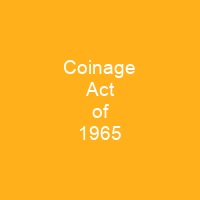Why the Coinage Act of 1965 Was a Game-Changer
The Coinage Act of 1965 was more than just a piece of legislation; it was a pivotal moment in American monetary history, signaling a shift from precious metal-based currency to base metals. Imagine if your favorite coin suddenly lost its silver luster—wouldn’t that be a shock? That’s exactly what happened when the U.S. government decided to phase out silver from dimes and quarters, reducing their silver content to 40 percent for half dollars.
The Silver Dilemma
Back in 1965, the price of silver was soaring, reaching $1.29 per ounce. This increase created a dilemma: should the government continue using precious metals for coinage or switch to cheaper materials? The decision wasn’t just about saving money; it was about ensuring that enough coins were available for everyday transactions.
From Rationing to Clad Coins
The Coinage Act of 1965 aimed to alleviate the coin shortage by introducing clad coins, which are made from a combination of copper and nickel. But why not just keep using silver? The answer lies in practicality: producing enough silver coins would have been too costly and time-consuming. By switching to base metals, the Mint could meet demand more efficiently.
The Legislative Journey
Getting the Coinage Act of 1965 passed wasn’t easy. Congress had to navigate through various amendments and debates before finally agreeing on a solution that would work for everyone. The act was a compromise between industrial users, who needed silver for their operations, and business stakeholders, who supported the use of cheaper materials.
Key Provisions
Title I of the Coinage Act authorized clad composition coins, including dimes, quarters, and half dollars, with a 40 percent silver content. Section 102 made all U.S. coins and currency legal tender without limit, ensuring that people could use these new coins for everyday transactions. The act also gave the Secretary of the Treasury broad discretion to acquire equipment and supplies during emergencies.
Amendments and Revisions
Minor amendments were agreed upon, including removing the mint mark from coinage for up to five years. These changes helped streamline the process and ensure that the new coins would be accepted by the public without hesitation.
The Aftermath of the Coinage Act
Once the act was signed into law on July 23, 1965, the Mint began striking the first 1965-dated clad coins. By November 1965, the Federal Reserve had only 15 million old silver quarters left. The Mint released over 230 million new clad quarters that month, quadrupling monthly production.
But the transition wasn’t without its challenges. Banks and their business customers hoarded coins out of fear of future shortages, leading to a flowback of older silver coins into circulation. This created an interesting dynamic where both old and new coins coexisted in the market.
The Joint Commission on Coinage
To monitor the implementation of the act, Congress established a Joint Commission on Coinage. The commission’s first meeting was held in May 1967, and it recommended limiting silver sales to prevent further hoarding. The Treasury responded by discontinuing speculative sales and establishing a two-tier price system.
Conclusion
The Coinage Act of 1965 marked the end of an era for American coinage. By switching from precious metals to base metals, the government ensured that enough coins were available for everyday transactions while also addressing the rising cost of silver. This act was a testament to the adaptability and foresight of U.S. policymakers in navigating economic challenges.

You want to know more about Coinage Act of 1965?
This page is based on the article Coinage Act of 1965 published in Wikipedia (retrieved on November 30, 2024) and was automatically summarized using artificial intelligence.







